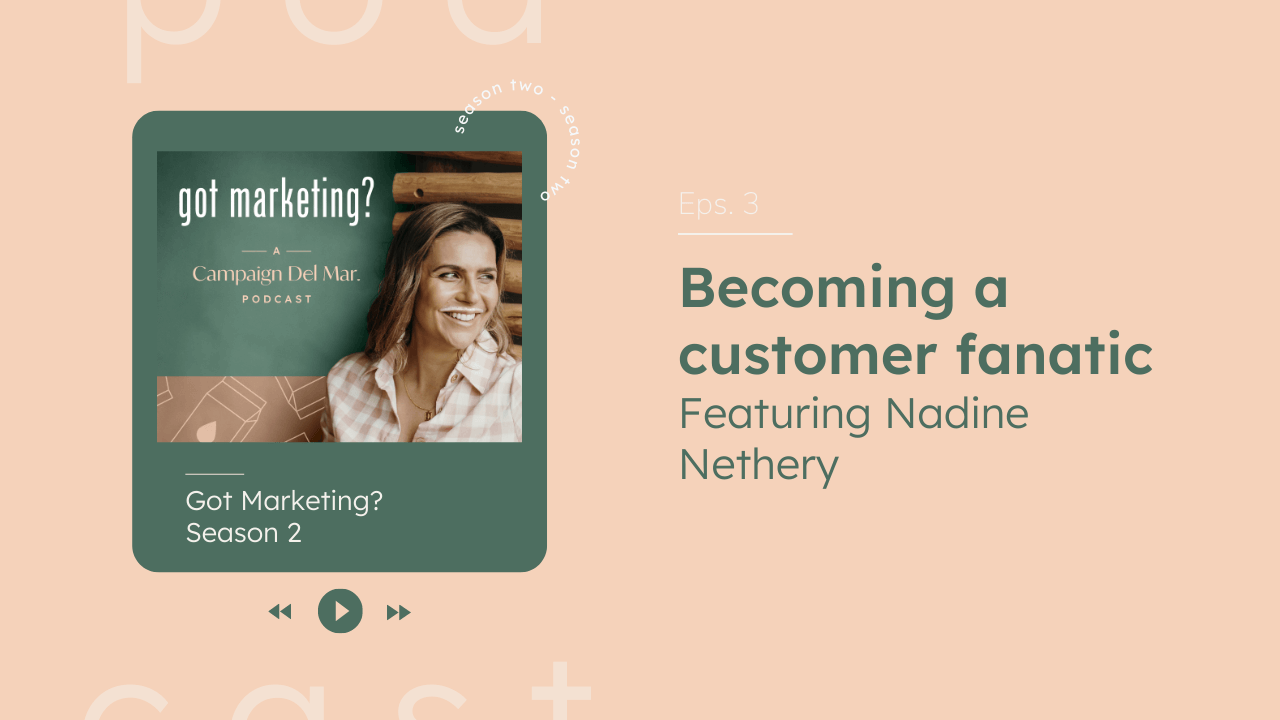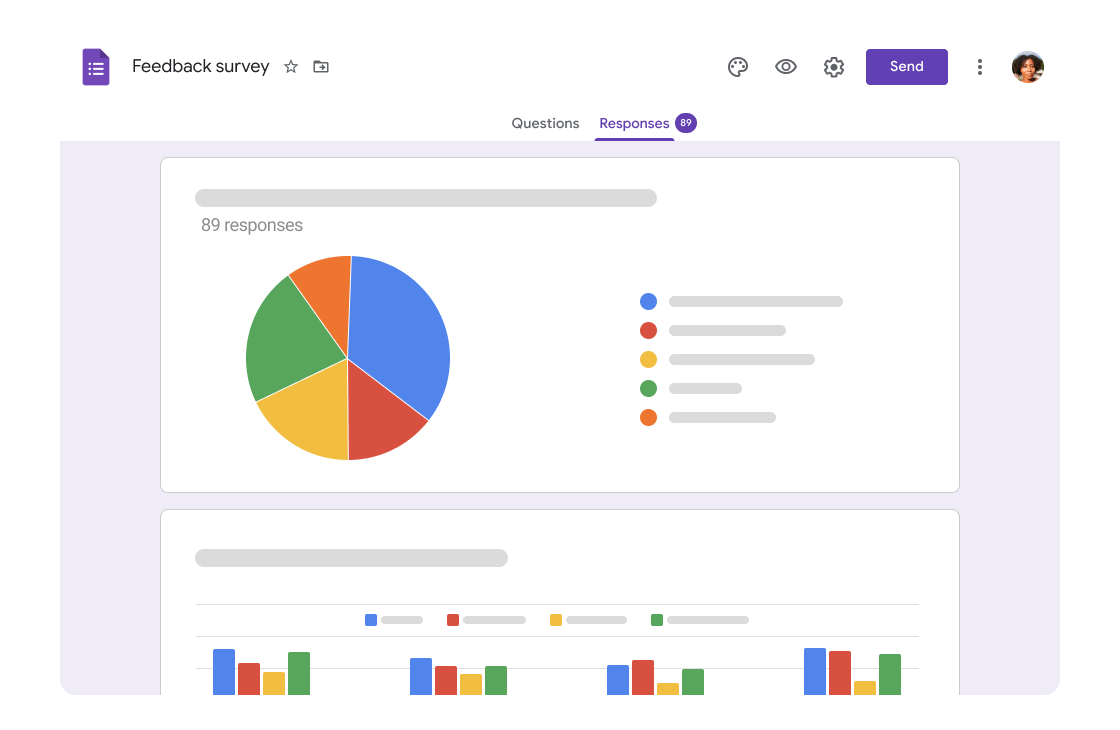Your Audience Holds the Secrets to Your Marketing | with Nadine Nethery
Dec 12, 2022
There's a lot of tone-deaf marketing around, with brands jumping on trends and fads that fizzle as quickly as they start. It's not rocket science - good marketing comes from good listening.
What helps marketers create memorable marketing campaigns are deep insights - genuinely getting to know your audience.
Mia was recently joined on the podcast by Nadine Nethery, founder of CAN DO! Content, a strategic copywriter for women-led brands. Mia and Nadine believe you should say no to plug-and-play copywriting templates and become a customer fanatic instead. Here, you can read why, and find some of the techniques and tips Mia and Nadine shared on how to gather valuable audience insights to inform your marketing on a shoestring budget.
Beware of plug-and-play copywriting templates.
Just because something works for someone else does not mean it will work for your brand.
"It's easy to look up to someone and think that their success can become yours by simply taking their formula and plugging your bits and pieces."
But the problem with that is:
"it takes the whole focus off your audience and actually speaking to their objections, their false beliefs, their desires, the current situation that they're currently in." - Nadine Nethery
Nadine Nethery (Image via CAN DO! Content)
Okay - but what if somebody else's audience is your audience, and they market to the same people that you market to, and they have the same offering, and they're in the same industry, and their customers are your customers, then why not use plug-and-play templates?
Because it's already been done.
Do you want to be the imposter brand?
Don't miss the opportunity to create something unique for your brand.
"You want people to associate certain terms, certain expressions, certain ways of saying things with your brand." - Nadine Nethery
You also want to remain consistent with your unique brand voice.
"If you simply copy what someone else has put out there, there's going to be that disconnect where the reader goes, 'Hang on. That is completely different to what this brand sent me two weeks ago.'" - Nadine Nethery
And another reason not to use plug-and-play copywriting templates? It's like you've been given the answers to the test – maybe not even your test, but somebody else's test – but none of the questions.
"Once you've got it out there, there is literally no opportunity for you to tweak things and work out why things aren't working simply because you don't understand the formula that went into the particular sales page or email sequence. You have no idea why people don't open the email, why they don't click, why they're not buying, and why things simply aren't happening for you." - Nadine Nethery
What to do instead? Nadine believes you need to start with your audience and build empathy and genuine interest in your customer.
Your audience holds the secrets to your marketing.
Become a customer fanatic.
Insights help marketers create genuinely memorable marketing campaigns.
Your audience will tell your everything you need to know. They hold the secrets to all of your marketing.
Nadine believes copywriting is:
20% - being a great writer, knowing the correct formulas and how to structure written content to guide the reader to the point you want them to get to.
80% - understanding your audience and using the exact terminology your audience uses to describe their problem - so that they nod along and feel truly heard, seen and understood. They are motivated to work with you because you are on the same page, you know their pain, and you are there to help them get to where they want to be.
"What you really want to piggyback off is the actual language and the sayings and getting to the bottom of how people describe their frame of mind, their problems, the things that are holding them back. You want to be able to reframe their problems in their own words. That saves you not only guesswork but also coming up with fluffy language which doesn't actually resonate." - Nadine Nethery
Marketers love using wonderful flowery language and jargon, but we often describe something in a way that customers never would.
Here at Campaign Del Mar, we have personally come up against this. No one – and I mean no one – really says in the morning, "Oh! I need a marketing campaign!" That's not the language that they use.
They say, "I need great marketing to launch my product", or "I need help getting my name out there." They don't say, "I need a marketing campaign."
This is where the voice of customer language comes in because if we are using terms and language that customers are using in our marketing, it's more likely to appeal to them.
How to gather valuable customer insights:
Gathering Customer Insights Technique 1: Surveys are your friend.
Nadine suggests starting your insight-gathering process with a customer survey. It can be super cost-effective with free tools like Google Forms, where you can create an on-brand survey you can then distribute to your existing customer list.
Image via Google Forms
If you're a service-based business, you can also survey those who inquired with you but didn't end up buying from you. This is a great way to get to know your audience's objections and where you can tweak your messaging or offer.
You need to ask the right questions to get the most out of your survey. Make sure you are using open-ended questions.
"It all starts with asking the right questions. So many times, I see brands send out surveys with the best intentions, but all I get is tick boxes and drop-downs where I'm giving you not much more than data to work with." - Nadine Nethery
Need some help getting started? Nadine gives us a look into the types of questions she might use:
"I take them on that journey from when they first realised that they had a problem.
What did that look like?
What was going on in their lives?
How did they go about fixing that problem?
What made you find the perfect solution?
What was going on while they were working with you or using your product?
How does their life look like now once they've worked with you and they've got that product in their lives?"
Keep it to a maximum of ten questions. We are all busy people!
But how do you get these busy people to answer your survey in the first place? Provide an incentive. Reward those who respond to your survey. This could be a gift card, a competition or a donation to charity. Mia does not recommend discounts because Mia doesn't like discounting.
"We are all somewhat selfish. Let's face it. If you get a survey request and there's something in it for you, you're much more likely to respond." - Nadine Nethery
Extra survey tip: Incorporate a question in your survey that asks whether the respondent is happy to jump on a call with you. Look out for people who were very generous with their responses and reach out to book a Zoom call with them so you can dig deeper and get them to elaborate on their initial answers.
This leads us to the next technique for gathering customer insights...
Gathering Customer Insights Technique 2: Talk to your customers.
Pick up the damn phone and talk to your customers.
This is scary for most people, but it shouldn't be. There is only so much your customers can give you in a survey.
Nadine Nethery (Image via CAN DO! Content)
Nadine recommends booking a Zoom call to interview customers.
"Eye contact just builds connection and, again, gives people a sense of security, especially if you frame the call at the beginning to take out that stress because – believe it or not – your opposite, the audience member who put their hand up to jump on a call with you, they are going to be just as scared and overwhelmed as you are." - Nadine Nethery
Set expectations at the beginning. Don't call it an interview; call it a chat. Assure them that there are no false answers.
"It's all about their honest opinion. They shouldn't be scared to be really, really brutally honest. That takes that pressure off. They may think that they need to give the answers that you want to hear, but you don't want that" - Nadine Nethery
Again, ask open-ended questions. Listen more than you talk. Let the other person speak, and do not interrupt. It will save you so much pain down the track, hearing their pain points directly rather than making assumptions.
Ask for permission to record the session so you can revisit and later transcribe the call. Nadine uses a service called otter.ai, where you can upload a video file, and it will transcribe the interview for you. This gives you an excellent opportunity to find those sticky terms and sentences. Using a transcription service also means you can focus and listen better during the chat and not feel like you need to scribble down notes frantically.
Quality over quantity
Only survey people who represent your ideal customer.
What your husband's aunty's cousin's daughter thinks about your marketing and branding is irrelevant. Not all opinions are equal.
One of the objections we hear to customer interviews is, "If I'm only doing five customer interviews, how statistically significant are those customer interviews?" This is qualitative data which is arguably just as important as quantitative data. Any discussions with your ideal customers are super relevant and valuable.
If you complete five interviews and you hear the same things, then patterns are emerging. It's likely that many other people in your target audience feel the same. If you already see a pattern in five interviews, you can bet your bottom dollar that it's happening across the broader audience segment.
"It's all about the quality over the quantity." - Nadine Nethery
Don't be afraid of negative responses
Why aren't all marketers already doing this? Well, one of the main reasons is that they are scared of what they might hear. They're worried that they've poured their life into a product or a service, and someone will say some not-so-nice things about it.
It's time to put on your big girl undies and get it done.
It's a non-negotiable in marketing to understand what your customers are saying. Rather than be defensive, if someone has something negative to say about your brand, you must try to remove any personal feelings and look at it objectively. Try not to take it personally.
There is an opportunity in the negative feedback to tweak your offering or messaging to be even more successful.
"Take it as a way to improve your business and continually learn and grow and implement processes that move you forward rather than hold you back." - Nadine Nethery
Gathering Customer Insights Technique 3: Tricks of the trade to get insights when you don't yet have customers.
But what if you don't already have an existing customer base to gather insights from?
Hang out where your ideal customer hangs out. Become a low-key stalker.
"Take a step back and work out where your ideal customers – the person that is perfectly positioned to buy your service or product – would hang out online. That can be Facebook Groups. Let's say you're selling baby products; your local mum community on Facebook would be the perfect place to start.
You can put a survey together again – surveys with a little incentive – to ask people. Or you can also listen and have a look at the common topics that people are talking about – things that are occupying mums that are on their mind all the time – then see how they relate to your solutions." - Nadine Nethery
Nadine Nethery (Image via CAN DO! Content)
For product-based businesses, look at reviews of similar products online.
"Sift through those again for sticky terms and themes that are coming up, things they are criticising, for example, or that were annoying them on your competitor product. It's all opportunities to tweak your product, your campaign, and your messaging to make sure you give them everything they want." - Nadine Nethery
Another trick of the trade is looking at the frequently asked questions about similar or competiting offerings. These are often the questions that people want to know the answers to that relate to your offering. FAQs are a hidden gem for finding objections that you need to address.
As a service-based business, you might see the FAQ "How long will it take for me to complete this project with you? Do you have a payment plan?" Then you know people want payment plans.
You've got your insights. Now what?
Sit down with a cuppa and take the time to sift through all the responses. Nadine suggests making a spreadsheet where you organise your findings.
"Look at any objections that are coming up, any needs and desires – what people are looking for, why they were coming to you in the first place, any false beliefs as well around price point potentially, around not having enough time. There are so many facets of beliefs that can hold people back from actually taking action. Then, the transformation – how their life looks different now."
"Sort it into these buckets. That will help you pick up themes and pillars and also sticky terms that keep popping up again and again." - Nadine Nethery
Ideally, you also rank insights by the frequency with that they come up.
Use this information as the starting point for any of your messaging or marketing.
Genuinely getting to know your audience can give you the clarity and confidence to write copy for your business, market in a way that resonates with your audience and build genuine connections that ultimately get your customer to take action.
In the podcast episode, Nadine discusses specific examples of how you can use the customer insights you've found in your copy.
"Your customers can say it so much better than you ever will. The number of times I sift through survey responses – I have 50 of them – and I read the one answer, then I go, 'This is it. Literally, it's the tagline. It is it!'" - Nadine Nethery
Spend time gathering customer insights. We promise it is worth it.
And to finish, a word of marketing advice from Nadine - "Lead with empathy – from a genuine place of wanting to help your audience because they're smart. They'll pick up if you're there to push an agenda or your own sales. Lead with empathy, and the rest is going to follow."
Listen to the full episode here, or via Spotify or Apple Podcasts.
Want more smarter marketing tips? Sign up for our free weekly roundup of ideas, case studies and news specifically designed for switched-on humans like you.

Written By
Mia Fileman
Marketing Strategist

Author
Mia Fileman
Marketing Strategist and Founder






